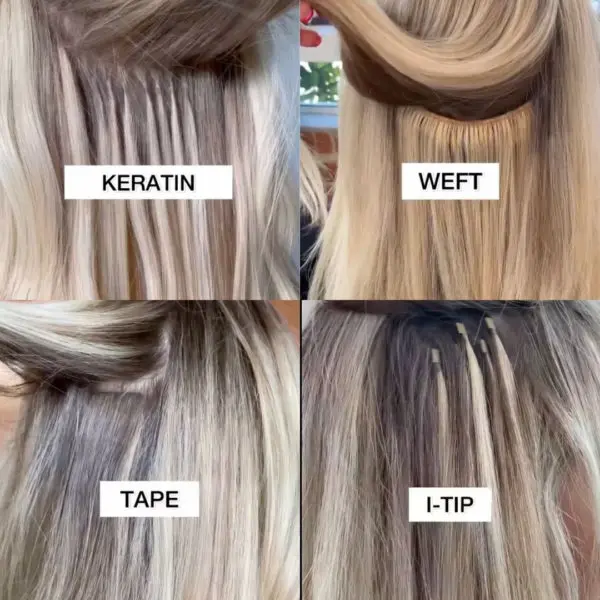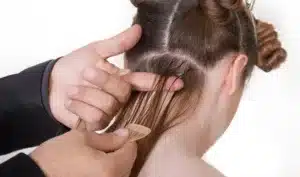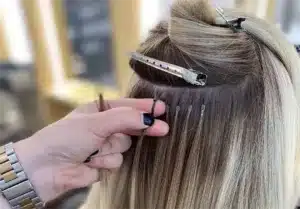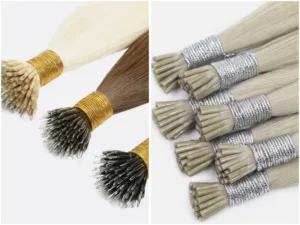Struggling in different extension methods? Don’t let the variety confuse you. Let’s break down each professional technique clearly.
From quick clip-ins,halo hair to regular weft, tape hair, keratin fusion to advanced V-Light , each method offers distinct results for your client’s needs.

Explore the differences below. You’ll learn how each method works, how to install it, and who it suits best.
What Is the different hair extensions methods
You want long-lasting, natural-looking extensions. The best method depends on hair condition, styling needs, and how long the client wants to wear them.
Dive Deeper
1. Clip‑In Extensions
- Definition:
Clip-ins are temporary wefts with sewn-in clips. They attach directly to the client’s natural hair. - Installation Steps:
- Start with clean, dry hair.
- Section hair horizontally from bottom to top.
- Snap the clips into natural hair close to the scalp.
- Blend and style as desired.
- Features:
- Install in 5–15 minutes.
- Zero damage.
- Reusable and easy to care for.
- Can be curled, styled, or dyed if made from full-cuticle human hair.
- Best For:
Brides, busy clients, first-timers, photoshoots, or clients wanting temporary volume and length.
2. Halo Extensions
- Definition:
A halo is a single hair weft attached to a transparent wire that sits around the crown like a headband. - Installation Steps:
- Part hair around the crown.
- Place the halo wire just behind the hairline.
- Release natural hair over the wire.
- Blend and brush through.
- Features:
- No clips, glue, or heat.
- Installs in 2–5 minutes.
- No strain on hair roots.
- Ideal for occasional wear or damaged hair.
- Best For:
Clients with fragile or thin hair, those looking for zero-damage styling, or beginners.
3. Tape-In Extensions
- Definition:
Tape-ins are thin wefts with adhesive strips that “sandwich” natural hair between two bonded pieces. - Installation Steps:
- Clean hair without conditioner.
- Section hair horizontally.
- Place one tape under a small section of natural hair.
- Press another weft on top.
- Repeat across the head.
- Features:
- Seamless, flat finish.
- Reusable 2–3 times with new tape.
- Lasts 6–8 weeks per installation.
- Lightweight but secure.
- Best For:
Salon clients wanting semi-permanent volume with minimal damage and easy repositioning.
4. Weft Extensions
- Definition:
Wefts are horizontal tracks of hair that are sewn or beaded into the client’s own hair.Like machine wefts,genius wefts.handtied wefts,flat wefts and etc., - Installation Steps:
- Create beaded foundation or small braids.
- Sew in thin wefts along the track or use beads to install.
- Features:
- Hand-tied: thin, flexible, lightweight.
- Machine weft: thick, high-volume, cost-effective.
- Lasts 8–12 weeks before reinstall.
- Requires professional stitching skills.
- Best For:
Clients with medium to thick hair who want long-term, full-volume transformations.
5. Hot Fusion Extensions
- Definition:
Hot fusion uses keratin U-tip/K tip/V tip/Flat tip strands that melt and bond to natural hair using a fusion iron. - Installation Steps:
- Divide hair into small sections.
- Heat the keratin tip with a fusion tool.
- Wrap the melted tip around natural hair.
- Hold to set.
- Repeat strand by strand.
- Features:
- Long-lasting hold (3–5 months).
- Bonds mimic natural hair flow.
- Requires removal solvent.
- Full-cuticle hair makes a big difference in durability.
- Best For:
Active clients, those who style daily, or who want discreet bonds and long wear.
6. Cold Fusion (I-Tip, Micro Ring)
- Definition:
Cold fusion attaches keratin I-tips to natural hair using micro beads or rings, with no heat. - Installation Steps:
- Pull a small natural hair strand through a bead.
- Insert the I-tip into the bead.
- Clamp with pliers.
- Repeat for the full head.
- Features:
- Heat-free, low-damage bonding.
- Can last 3–5 months.
- Easy to remove and reapply.
- Full-cuticle hair avoids tangling and matting.
- Best For:
Clients with sensitive scalps, thin or heat-damaged hair.
7. V-Light Extensions
- Definition:
V-Light is a newer method using small, V-shaped keratin bonds installed with low heat. - Installation Steps:
- Select fine strands of natural hair.
- Wrap a V-shaped keratin tip around the strand.
- Heat and bond securely.
- Blend and cut.
- Features:
- Ultra-light, virtually invisible.
- Minimal bulk, smooth finish.
- Lasts up to 3–5 months.
- Ideal for crown area and fill-in volume.
- Best For:
Clients with fine or thinning hair needing invisible root lift.
Pros & Cons Compared?
Each method has unique strengths and limitations. Consider the fit for different client types and lifestyles,but if the best full cuticle grade hair extensions:
| Method | Wear Time (Before next move up) | Damage Risk | Install Time | Blend Ease | Cost | Best For |
|---|---|---|---|---|---|---|
| Clip‑In | One day/event | None | 5–15 min | Very Easy | Low–Mid | Clients who change looks often or need event volume |
| Halo | One day/event | None | 2–5 min | Very Easy | Low–Mid | Fine hair, no-clip preference, beginners |
| Tape‑In | 6–8 weeks | Low–Medium | 30–60 min | Good | Mid–High | Brides, professional clients, medium wear |
| Weft | 8–12 weeks | Low–Medium | 60–120 min | Excellent | Mid–High | Regular stylists, structured styles, heavy styles |
| Hot Fusion | 3–5 months | Medium–High | 90–180 min | Excellent | High | Long-term, active clients, frequent styling |
| Cold Fusion | 3–5 months | Low–Medium | 90–180 min | Excellent | High | Clients sensitive to heat, long wear |
| V‑Light | 3–5 months | Low–Medium | 30–60 min | Excellent | High | Thin hair seeking invisible lift |
Best Hair Extension Method for Thin Hair?
Thin hair needs gentle methods that won’t weigh it down or damage fragile strands.
The best methods are V-Light, Halo, and Tape-in using full-cuticle hair. These are lightweight, discreet, and provide secure hold without strain.
Why It Works:
- V-Light: Bonds are invisible and small, good for crown and fill-in.
- Halo: No glue or clips, rests on the crown—not the roots.
- Tape-In: Use thin, single-sided tape for less tension. Full-cuticle hair prevents tangling.

Best Hair Extension Method for Short Hair?
Short hair can be tricky but not impossible. The goal is seamless blending and reliable hold.
The best methods are tape-in, fusion (hot or cold), and weft if hair is at least chin-length.
Why It Works:
- Tape-In: Lays flat and blends well. Can layer to hide short layers.
- Fusion: Strand-by-strand install allows flexible styling and movement.
- Weft: Hand-tied works well for bob-length hair with correct placement.
How to Choose the Right Method?
Match extension types with:
- Client Lifestyle
- Hair Health
- Stylist Skill
- Budget
Think long-term vs short-term, ease of maintenance, and wearability.

My Opinion
I favor full‑cuticle grade hair extensions in different methods for most wholesalers.Each type of hair extension method has its own characteristics. We recommend and install them according to the customer’s situation and preferences. However, in terms of quality, only full cuticle grade is the most outstanding and long-lasting. It is related to the brand reputation of wholesalers. We still recommend using the best quality hair extensions.
FAQ
Q: Which extension method is safest for hair?
A: Clip-ins and halos. They cause zero stress on roots.
Q: How often should clients replace extensions?
A: If best full cuticle grade hair,Fusion: every 4–5 months. Tape: every 6–8 weeks. Clip-ins/halo: as needed.
Q: Can I combine methods?
A: Yes. For example, halo for crown + weft in back.
Q: Does the hair quality matter more than the method?
A: Yes. Full-cuticle human hair extends wear time and prevents matting.
Q: Can short hair use clip-ins?
A: Yes—but placement and layering need care for blending.
Q: Do I need special tools for installation?
A: Fusion methods require heating irons. Wefts need sewing tools. Others need clips, beads, or tape.
Q: What type works best for color-treated hair?
A: Tape-ins and wefts with full-cuticle Remy hair work well. Always color test first.
Q: Which one is fastest to install in salon?
A: Tape-ins or halo—done under an hour.
Conclusion
Choosing the right extension method depends on lifestyle, budget, and hair type. For long-term wear, fusion and wefts lead. For quick changes, halo and clip-ins are winners.
where to buy i tip hair extensions
Hibiscus Hair Manufacturer has been dedicated to producing high-quality I tip hair extensions for 25 years and is a recognized leader in the industry. If you are interested in finding a reliable hair extensions supplier and wholesale for your brand, please visit our website for more information:插入网址 https://www.hibiscushair.com/keratin-hair/i-tip-hair-extensions/




